In New York, UPM and associate producer Mary Rae Thewlis (center) on the set of Law and Order: Criminal Intent with fellow DGA members John L. Roman, Michael Smith and Fred Berner
There has been a lot of talk — and action, too — centered on the runaway production crisis facing the U.S. entertainment industry during the past few years. To those directors, ADs and UPMs who make their living in film and television in the United States, the ongoing exodus to Canada, Australia and other countries offering attractive incentives is no joke. The good news, however, is that the tide may be turning back slightly. New Mexico, New Jersey, Illinois and Louisiana have recently passed legislation that provides attractive incentives for film crews in those states. And Los Angeles and New York are beginning to bustle again with production. Even when there isn't fiscal/budget parity with foreign locales, shoots are locating to several urban American centers for both logistical and creative reasons.
Here is one look at the way the U.S. location shooting map stacks up at present:
Plenty of films are shooting here now. In addition, television producer Dick Wolf has insisted that his three Law & Orders (the original and its spinoffs Law & Order: Special Victims Unit and Law & Order: Criminal Intent) be filmed here for reasons of authenticity.
Joe Reidy, who has served as 1st AD with Martin Scorsese on 10 of his films — including Gangs of New York (shot primarily in Italy), The Age of Innocence, Cape Fear, Casino, Goodfellas and The Last Temptation of Christ, maintains that "there's an energy coming from New York that you'll find nowhere else in the United States."
Reidy adds, "I mean, New York may not be the center of the film industry, but it's the center of high American culture, of business, of the media, of fashion, of finance. And then there's the acting community. Between Broadway and off-Broadway, there's a tremendous pool to draw from. And the city has a tradition of filmmaking that goes back to the Silent Era. In New York, you can find high-level, hard-working crews in every category comparable to Los Angeles."
There is also the "spirit of energy of the people who live there" that gives New York an added edge, Reidy believes. "It's a city with a lot of character. And I know it's become a cliché, but the city is like another character in the film. You can't find that in Toronto."
Peter Leto, UPM on Law & Order: Special Victims Unit, notes that creator-producer Wolf is adamant that his shows film in New York since that's where they happen to be set.
"It's not prohibitively expensive, either," Leto says. "We're able to do what we want to do in terms of storytelling without compromise. And I mean, why cheat your story? Why go to Canada when you can't look up and down with your camera there? All you can look is left or right — never up and down.
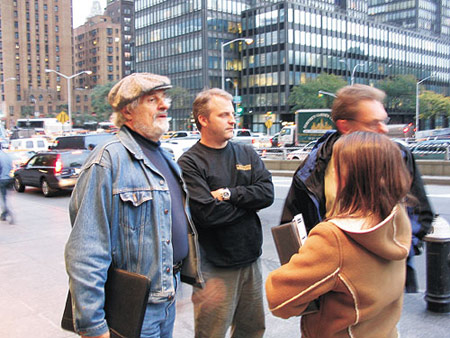
Executive producer/director Ted Kotcheff and producer/UPM Peter Leto scouting Manhattan locations for the 100th episode of Law & Order: Special Victims Unit
"There's also no place like New York for the rich texture we're looking for on Special Victims Unit. We're able to travel from Harlem to Wall Street to Times Square to SoHo. All of those neighborhoods really give you a different flavor in each story you're trying to tell."
Mary Rae Thewlis, UPM and associate producer on Law & Order: Criminal Intent, agrees that the complexity of the city and its boroughs make New York an uncommonly rich shooting location.
"We go all over the place on our show," she says, "and that gives us a lot of different looks we couldn't duplicate anyplace else. I mean, we shot at a farm in Queens yesterday. A farm! I saw a cornfield yesterday with goats and pigs — in New York. So it's not as if we're only restricted to concrete and metal and urban jungle."
Thewlis says that New York has grown to become even more film-friendly in recent years, specifically pointing to the historic problems surrounding parking and the way the productions sometimes take away premium spaces from the locals. "But I think everyone is cognizant of the fact that we're here helping create jobs for the city. That obviously goes a long way."
Mark Kamine, a UPM who has worked on The Sopranos since the show's beginning in 1999, says that the show's creator and executive producer David Chase has insisted from the get-go that the show be filmed in the location where it is set. And HBO has dutifully followed his wishes.
"The distinctive Jersey skyline and architecture and that whole industrial feel really add to the character of the show," Kamine says. "That would be nearly impossible to duplicate outside of this area."
The NBC series Ed, meanwhile, is notable in that Northvale, N.J. (where it is shot), subs for the quirky midwestern town of Stuckeyville, Ohio. The show's UPM, Michael Stricks, finds that New Jersey and Ohio have more similarities than people might imagine.
"Jersey has a lot of the same quaint, small-town aspects," Stricks says. "And because we're shooting in the Northeast, we also get plenty of seasonal variations."
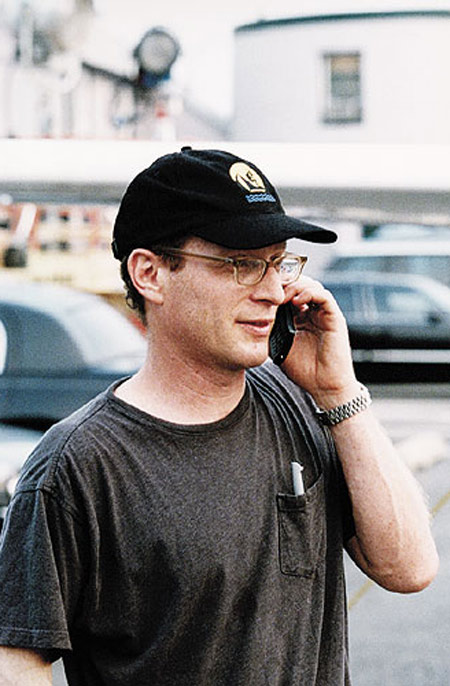
(Top) In New Jersey, UPM Mark Kamine of The Sopranos (below) In Los Angeles, 1st AD Michael Klck (right) on the set of 24 with cameraman
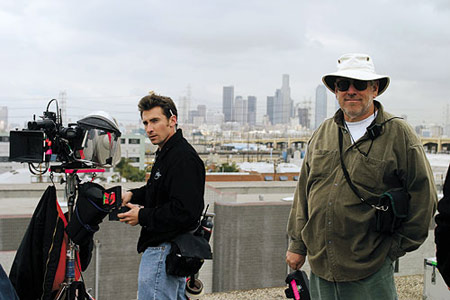
The center of the film industry has also suffered a decline as a result of runaway production. But changes over the past few years have made it a better and more attractive place to work, contends Cleve Landsberg, a UPM in both feature films and TV whose past assignments have included Bruce Almighty and Weekend at Bernie's.
"Over the years many dedicated movie professionals have worked hard to make Los Angeles a more film-friendly environment," Landsberg says. "We not only live here, but the streets of Los Angeles are our offices and our workplace. We know that when we go into an area to shoot a film, we are working where people live. We strive to be considerate and responsive to the concerns of residents. By the same token, many people in L.A. recognize the importance of movie production to the local economy and welcome us. I encourage our crews to make the residents feel a part of our film community."
Landsberg contends that while more needs to be done to stem the tide of production defection to Canada and other foreign countries, he sees plenty of positives to shooting in L.A. that aren't available elsewhere.
"L.A. provides incredible access for getting all kinds of special items on short notice, not to mention a talent pool that's second to none," he says. "And the speed with which you can shift gears and do things in Los Angeles can't be underestimated. There's more infrastructure in L.A. than anyplace else in the world. That remains a tremendous advantage. The speed with which you can get stuff done in L.A. is an underrated tool for economizing with quality."
Two of the more high-profile TV productions that shoot in L.A. are the Fox action hour 24 and the gritty FX cop drama The Shield, both of them Emmy winners and both highly acclaimed by the critical community. Both also happen to be set in Los Angeles.
Scott Brazil, an executive producer and regular director on The Shield who was also a producer and director on Hill Street Blues, acknowledges that the studio originally wanted to budget the show for Vancouver or New Zealand.
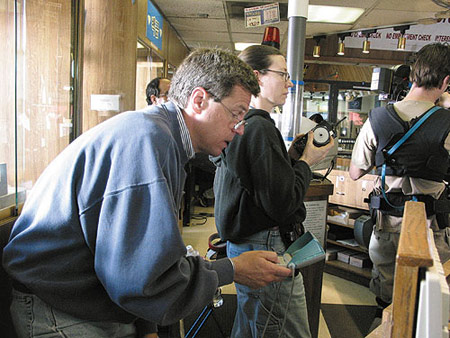
(Top) In Los Angeles, director/executive producer Scott Brazil on the interior of The Shield (below) Keifer Sutherland, as agent Jak Bauer, on location at the L.A. Coliseum for a scene in 24
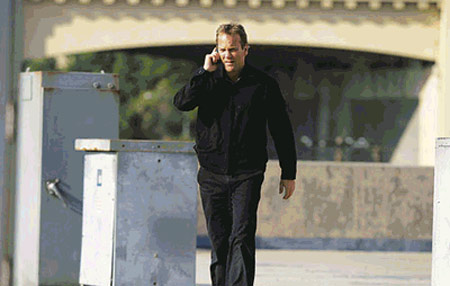
"We just told them that they needed to let us know how much money we'd have to spend to make the show and we'd find a way to make it in L.A.," Brazil recalls. "We've fortunately been able to do that because we have a lot of concessions to make it work. Everybody earns less than their quotes — the actors and all of the producers and writers, too."
Why fight to keep the show in L.A.? Because, as Brazil says, "The truth is that you'd never find any of our exteriors in Vancouver. We shoot in the most beautiful lower income areas of Los Angeles and Boyle Heights. For us, it's really rich and ethnically diverse and colorful. You wouldn't find anywhere close to that diversity or color north of the border, which tends to be very homogenized. It simply wouldn't work for our storytelling."
Clark Johnson, who directed The Shield's pilot and who also directed last summer's hit big-screen version of S.W.A.T., agrees with Brazil that the show could no doubt be shot cheaper in Vancouver but would lose much in the on-screen look as a result.
"We had to do this in L.A.; it's as simple as that," Johnson says. "It wasn't just for visual reasons, either. You've also got the best crews in the world here."
Meanwhile, on 24, 1st AD Richard Rosser also maintains that little of what the show depicts could be duplicated in Toronto or Vancouver for his show.
"The wasteland of concrete and the massive expanse of L.A. played into the first two seasons more than anyone could have guessed," Rosser points out. "During our daylight hours, there's this whole hot pavement, sort of brown, dusty feel that plays into the Los Angeles dynamic."
Adds fellow 24 1st AD Michael Klick: "It can be tough shooting in L.A. because of all the permits and restrictions. Everything in L.A. has restrictions attached. And I guess that the reason is pretty obvious. There are places in L.A. where they have 50 or 60 shoots a year. And people get tired of it.
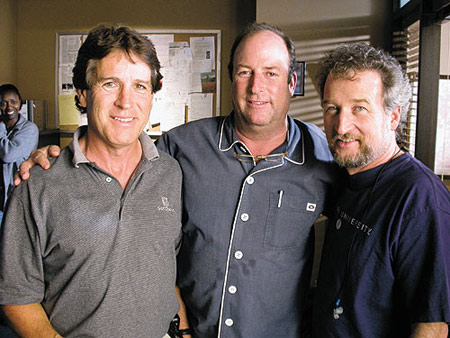
(Below) On the Los Angeles set of The District are (from left) UPM Cleve Landsberg, producer Tom Irvine and director Kevin Dowling
Then there is the upside to shooting in L.A. "We get to photograph Los Angeles as Los Angeles," Klick says. "Most shows go to great lengths to try to hide that fact. I spent 25 years making commercials. Our mantra was, 'No tile roofs, no palm trees,' because they don't have those in Chicago and Cleveland. But on 24, we can revel in the city's landmarks and distinction. We shot our last episode last year at the L.A. Coliseum."
Jon Cassar, the in-house director for 24 who handles those duties on 10 of the episodes each season, emphasizes that it isn't as if the production has any choice other than shooting in Los Angeles.
"Remember, we need to show the consistency of weather because it's all supposed to take place in a single day," Cassar says, "and in our case we spread that day over 11 months. For that reason alone we could never shoot in Canada."
One advantage for being in L.A. is the fact that the city provides such a variety of contrasts for exteriors. "We can capture the gritty when we need it and the beautiful when we need that," Cassar, a transplanted Toronto native, adds. "We love showing both sides of it. It's what distinguishes the area from so many others. And it gives the show a truly distinctive look and feel."
Andrew Davis admits to a certain bias when it comes to shooting many of his movies in Chicago. It's his hometown, for one thing. So it's no accident that he's filmed The Fugitive, Above the Law, Code of Silence, The Package and Chain Reaction there. But he also emphasizes that his desire to use the city as a production hub and cinematic backdrop goes far deeper than that.
"You can't cheat the location and make Toronto look like Chicago," Davis believes. "Chicago gives a unique look to a film. It has a lot of character. It also gives great cooperation as a city. They're not so jaded to production from shooting all the time there. The fees also are less, and they're a lot more open to letting you do things."
Beyond that, Davis finds that he "knows how the city functions, the way traffic works and doesn't work and how to use the city as a character in the movie." So please don't ask him to travel north of the border to depict the Windy City. He's already upset at the way that too much production is heading north to Canada.
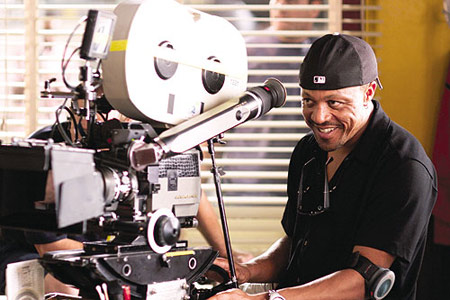
Director Kevin Rodney Sullivan in Chicago for Barbershop 2
"It's not that I have anything against the Canadians or Canada," he says. "But you've got limited casting resources up there. And it disturbs me the way production people in Chicago are losing their homes and families and livelihoods" because of the economic and personal pressures brought to bare by runaway production.
Barbershop 2 director Kevin Rodney Sullivan — who also directed How Stella Got Her Groove Back — acknowledges that Chicago was chosen as the location for the Barbershop sequel because it's the hometown of producers Robert Teitel and George Tillman, Jr.
"But it was great to be there," Sullivan says. "It was a very smooth shoot. We shot on the L-trains, in downtown, on the South Side. Everybody was very cooperative. The police department was terrific to work with. It wasn't difficult to get locations. They wanted us to be successful and wanted it to be easy for us."
While Sullivan and the Barbershop 2 shoot were in town, in fact, Illinois Gov. Rod Blagojevich came to the set to sign the new state bill creating tax incentives for film companies. (click here to see the story on the legislation). A huge throng of media and public officials attended it. The legislation is expected to draw more production to Illinois.
From a director's standpoint, Sullivan said that the city is a dream because of the enormous amount of talent congregated there. For Barbershop 2, "We had 150 speaking roles and were able to cast most of them in Chicago," he says. "You've got Second City, the Steppenwolf Theatre Company, Northwestern University and the Goodman Theatre to draw actors from. It's not like you're having to fly actors in."
Taylor Hackford, who previously directed An Officer and a Gentleman, White Nights and Proof of Life, knew one thing going into shooting his Ray Charles feature biopic Unchain My Heart. It couldn't be done in Canada.
"There was pressure to take it up there, and it would have been cheaper," Hackford says. "But my insistence was immediate and continued. I would not have done that. They'd have had to get themselves a different director. We needed to have a location that would work for the American South, where you could really feel it. Toronto is fabulous and they have great crews, but it would never give you a credible sense of the South. And Ray Charles was still a country boy from Georgia."
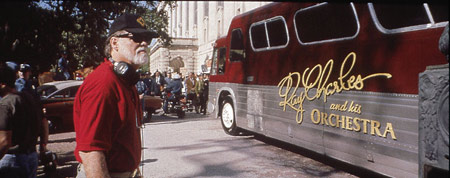
Director Taylor Hackford on location in Louisiana for his film Unchain My Heart
But Hackford didn't want to make the film in Georgia, either. He thought about Atlanta. It felt too modern to him, however, to easily stand in for the old South. Very little in the city is truly period.
New Orleans, however, was another story. There was also the tax incentive issue (passed by the state legislature in July 2002) that made it an attractive locale. In just the past year, film production in the state topped the $100 million mark for the first time after previously averaging $20 million to $30 million a year.
"We were able to reduce our budget by close to $5 million as a result of that," Hackford estimates. "That's real money we're talking about. But we still wound up spending more than $20 million in the Louisiana area."
You won't find a whole lot of film and TV production in Cleveland. But there was one NBC made-for-TV movie shooting there throughout the summer and into October that carried the working title Deep Attack, an action flick starring Billy Zane of Titanic fame.
Why Cleveland? To hear the film's director Louis Morneau describe it, there's no great mystery to it, simply the usual explanation: producer Alan Schechter is from there and had previously made several films in the city.
"We invariably realized it was more cost-effective to come here," Morneau says. "Shooting a big action film in Cleveland like we are has all kinds of hidden benefits. The city is really doing a great deal for us. We've been able to shut down major highways for an entire day of filming. We've shut down three or four different bridges for two, three, four days at a time. We were even able to take over large sections of the main airport for a couple of days. I can't think of another city that would have allowed us to do anything close to that."
Morneau adds that the production has been afforded "huge access to just about everything. The city made it quite clear at the outset that it would be completely cooperative and it has been. It's worked out brilliantly. I guess they don't get a lot of filming here, and we haven't had to pay any location fees. There's a huge sequence with police cars and fire trucks and ambulances, and the city gave it all to us gratis."
To be perfectly blunt, New Mexico gave the makers of the independent feature Elvis Has Left the Building an offer they couldn't refuse. Director Joel Zwick (My Big Fat Greek Wedding) was still shooting it in early October when he took a moment to marvel about the production's treatment from the New Mexico Film Commission.
"We came to New Mexico on a pre-scout for locations," he recalls. "They took us out and scouted all of the locations we'd need in the movie and prepped them for us, chauffeuring us all over town. They convinced us within two days we could shoot our movie in Albuquerque. And they made the deal phenomenally attractive."

(Top) Shiprock, NM, location used in Natural Born Killers, Pontiac Moon and Made in the U.S.A.
Zwick says that the location scout included free hotels, restaurants and transportation — an unheard of series of perks in any normal circumstance. And once shooting began, they got use of the local convention center for five days without having to pay a penny.
What's more, since Elvis Has Left the Building is a road movie, the area had to stand in for many different areas and towns, including Lubbock, Amarillo, Arizona, Las Vegas and Memphis. Albuquerque subbed for them all.
"These people made it possible to do this movie amazingly cheaply, probably under $10 million," Zwick believes. "They've been very good to us. It's almost like a pilot program, so it's important to them that we succeed. They've worked very hard to ensure that we do. They're very excited to have filmmakers in town. No one said we shouldn't be shooting in that neighborhood or stay out of that house. It's a very open area right now in terms of shooting."
The city by the bay has been the setting for many classic films over the years — Alfred Hitchcock's Vertigo, Peter Yates' Bullitt, Don Siegel's Dirty Harry. Add in films like DOA, Mrs. Doubtfire, The Rock, The Presidio, Escape From Alcatraz, The Hulk and more. It even featured prominently in such staples of network television as Ironside and the Karl Malden/Michael Douglas vehicle The Streets of San Francisco as well as the more recent Nash Bridges.
San Francisco's unique geography and lifestyle have provided inspiration for countless filmmakers. But lately, the city and its component of DGA members have seen a fall off in production. While films such as Michael Apted's Enough and John McTiernan's Rollerball featured S.F. Bay Area location shooting, AD David Hakim of the DGA's San Francisco Coordinating Committee said the last big economic boost came from the extended Bay Area shooting of The Matrix: Reloaded and The Matrix: Revolutions in 2001, as well as Philip Kaufman's Twisted (a.k.a. The Blackout Murders) in 2002.
"The Matrix films alone pumped $50 million into the local economy," Hakim said. "They built the longest set ever constructed: a 1.75-mile section of freeway on Alameda Naval Airstation's runway with a view of San Francisco. All that construction was done here. We had hundreds of extras and cars, stunt players, precision drivers and a lot of the casting was done up here.
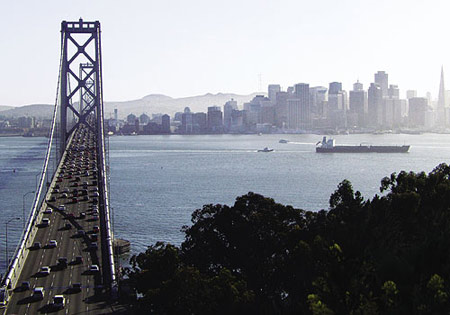
Frequently shot San Francisco skyline from view of Oakland Bay Bridge
"Ami Zins [Film Coordinator of the Oakland Film Office] pretty much got them here. She was deeply involved in making it work and bringing those films to the area," Hakim said.
"We've got top crews here. We've got shooters, precision drivers, well-known actors such as Peter Coyote, Delroy Lindo, Robin Williams, Sharon Stone, Sean and Robin Wright Penn live in the area. The San Francisco Bay Area has a huge pool of talent."
But after Kaufman's Twisted wrapped, it has been "dead" except for very low-budget films. It doesn't help when a series such as Monk, in which the setting is San Francisco, shot its first season in Vancouver and Toronto. For the second season, according to The Associated Press and The Hollywood Reporter, the show moved from Canada to Los Angeles "for artistic reasons and to be closer to home for the cast and crew" and that "the cost per episode will rise to about $1.7 million, compared with about $1.5 million in the first season." Though now shot in Los Angeles, the stories still retain their San Francisco setting with Southern California doubling for the Bay.
"Losing Nash Bridges (which ceased production in 2001 after six seasons) was a huge hit for the local economy," Hakim added. "Shows like Nash provide work and groom people to move up in all disciplines. Then, because those shows take workers out of the available pool, when other productions arrive they provide jobs that can be filled with newer people or workers who might not have worked otherwise. So Nash and shows like it provided many opportunities. Without a show like that in any region, the entire range of Guild and union members suffer, especially when the general trend is a slowdown of work."
Of the nine counties bordering the San Francisco Bay, most have film commissions that are ready and eager to work with producers to facilitate production.
The Good News: Hakim reports that there's been a huge recognition by local officials that the loss of film and television production negatively affects the local economy. "We're in the midst of a mayoral election in San Francisco. I serve on the Bay Area Film Alliance, which produced a mayoral debate about filming in San Francisco — and all of the candidates promised that they'd work to make the city more film-friendly. They discussed permit fees, police fees, and the need for a film commission that will go to Los Angeles to work with the studio heads to help meet the needs of the studios. So, even though it's been rough for a while, we now hope to have a much more supportive local government in San Francisco."
The bottom line — it appears that many state and local governments realize the economic benefits of production companies shooting in their locations. Many are devising ways to lure production back from Canada, and that's just fine for DGA members who'd rather stay closer to home.